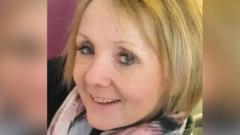Did a Nurse's Collision at the Hospital Lead to a Woman's Death?

A Tragic Incident: The Death of Mary Owen-Jones
On January 1, 2023, the community of Rhos-on-Sea, Conwy County, was shaken by a tragic event that claimed the life of 51-year-old Mary Owen-Jones. After visiting her newborn grandchild, she was struck by a vehicle driven by nurse Chloe Thelwell outside Glan Clwyd Hospital in Denbighshire. An inquest into this heartbreaking incident revealed several contributing factors that led to Ms. Owen-Jones's untimely death. This article aims to provide a comprehensive overview of the incident, the inquest findings, and the broader implications for road safety and medical professionals.
Background of the Incident
Mary Owen-Jones had just left the hospital, filled with joy from her visit to her grandchild. Unfortunately, her life took a tragic turn moments later. As she crossed the hospital grounds, she was struck by a vehicle driven by Chloe Thelwell, who was completing her shift at the facility. The impact was severe enough to leave Ms. Owen-Jones with critical injuries, including a broken leg and a subsequent bleed on the brain.
The Inquest Findings
The inquest, conducted in Ruthin, unveiled a series of events that contributed to the accident. Coroner John Gittins recorded a conclusion of death resulting from a road traffic collision, emphasizing the combination of multiple factors that led to this tragic outcome.
Factors Leading to the Collision
Several key factors were identified during the inquest, including:
- Driver's Behavior: Chloe Thelwell admitted to cutting a corner while exiting the hospital's main car park. She was driving at a speed of 10-15 mph, which is close to the advisory limit of 10 mph within the hospital grounds.
- Visibility Issues: Witnesses reported that Ms. Thelwell appeared distraught and mentioned she "didn't see" Ms. Owen-Jones. Eyewitness Dewi Wyn Williams noted that the windscreen of Ms. Thelwell's Audi was completely misted up, raising concerns about her visibility.
- Crossing Behavior: Ms. Owen-Jones was wearing dark clothing and crossed a few meters from an illuminated pedestrian crossing. According to forensic crash investigator Ian Thompson, she should have been able to see the vehicle's headlights and indicators.
- Medical Complications: The inquest revealed that Ms. Owen-Jones had been prescribed anticoagulant Warfarin following a heart operation. This medication exacerbated the bleed on her brain, significantly impacting her chances of survival.
Legal Considerations
The tragic collision raised questions about legal accountability and the possibility of criminal charges. The Crown Prosecution Service considered charging Ms. Thelwell with causing death by dangerous driving but ultimately concluded that there was no realistic prospect of a jury finding her guilty.
Coroner John Gittins highlighted that the combination of all elements—driver error, visibility issues, and medical factors—played a significant role in the fatal outcome. This conclusion underscores the complexity of such incidents and the challenges faced in attributing blame in road traffic collisions.
Implications for Road Safety
This unfortunate incident serves as a stark reminder of the importance of road safety, particularly in hospital areas where pedestrians and vehicles often share space. It prompts a reevaluation of safety measures in such settings, including:
- Improved Signage: Clear and visible signage indicating pedestrian crossings and speed limits can help drivers remain aware of their surroundings.
- Enhanced Visibility: Hospitals should consider implementing measures to improve visibility for drivers, especially in areas with high foot traffic. This could include better lighting and regular maintenance of road surfaces.
- Driver Training: Healthcare professionals who drive as part of their job should receive training on safe driving practices, particularly in hospital environments.
Community Response and Support
The community of Rhos-on-Sea has expressed its sorrow over the loss of Mary Owen-Jones. Family and friends have come together to support one another during this difficult time. The tragedy has sparked conversations about pedestrian safety and the need for greater awareness among drivers, especially in areas frequented by vulnerable individuals.
As the community mourns the loss of a beloved member, it also reflects on the broader implications of road safety and the responsibilities that come with operating a vehicle, particularly in sensitive environments like hospitals.
Conclusion
The tragic passing of Mary Owen-Jones serves as a poignant reminder of the fragility of life and the unforeseen consequences of everyday actions. While the inquest provided insights into the factors leading to the accident, it also highlights the need for ongoing discussions about road safety and the importance of vigilance among drivers. The community's response underscores the emotional impact of such events and the critical importance of measures to prevent similar tragedies in the future.
As we reflect on this incident, it raises an important question about how we can collectively work towards ensuring safer environments for pedestrians and drivers alike. In what ways can communities enhance road safety to prevent such heartbreaking accidents?
FAQs
What happened to Mary Owen-Jones?
Mary Owen-Jones was struck by a vehicle driven by a nurse outside Glan Clwyd Hospital after visiting her newborn grandchild. She suffered critical injuries and later died due to complications from a bleed on the brain.
What were the factors that contributed to the accident?
Key factors included the driver's behavior (cutting a corner and possible visibility issues), the pedestrian's crossing behavior (wearing dark clothing and crossing away from a pedestrian crossing), and medical complications exacerbated by medication.
Was the driver charged with any crime?
The Crown Prosecution Service considered charging the driver with causing death by dangerous driving but ultimately decided there was no realistic prospect of a jury finding her guilty.
What can be done to improve road safety in hospital areas?
Improvements could include better signage, enhanced visibility for drivers, and driver training focused on safe practices in pedestrian-heavy areas.
As communities reflect on the lessons learned from this tragic incident, the question remains: what proactive steps can we take to ensure the safety of both pedestrians and drivers in shared spaces? #RoadSafety #CommunityAwareness #PreventTragedies
Published: 2025-07-04 16:38:09 | Category: wales



